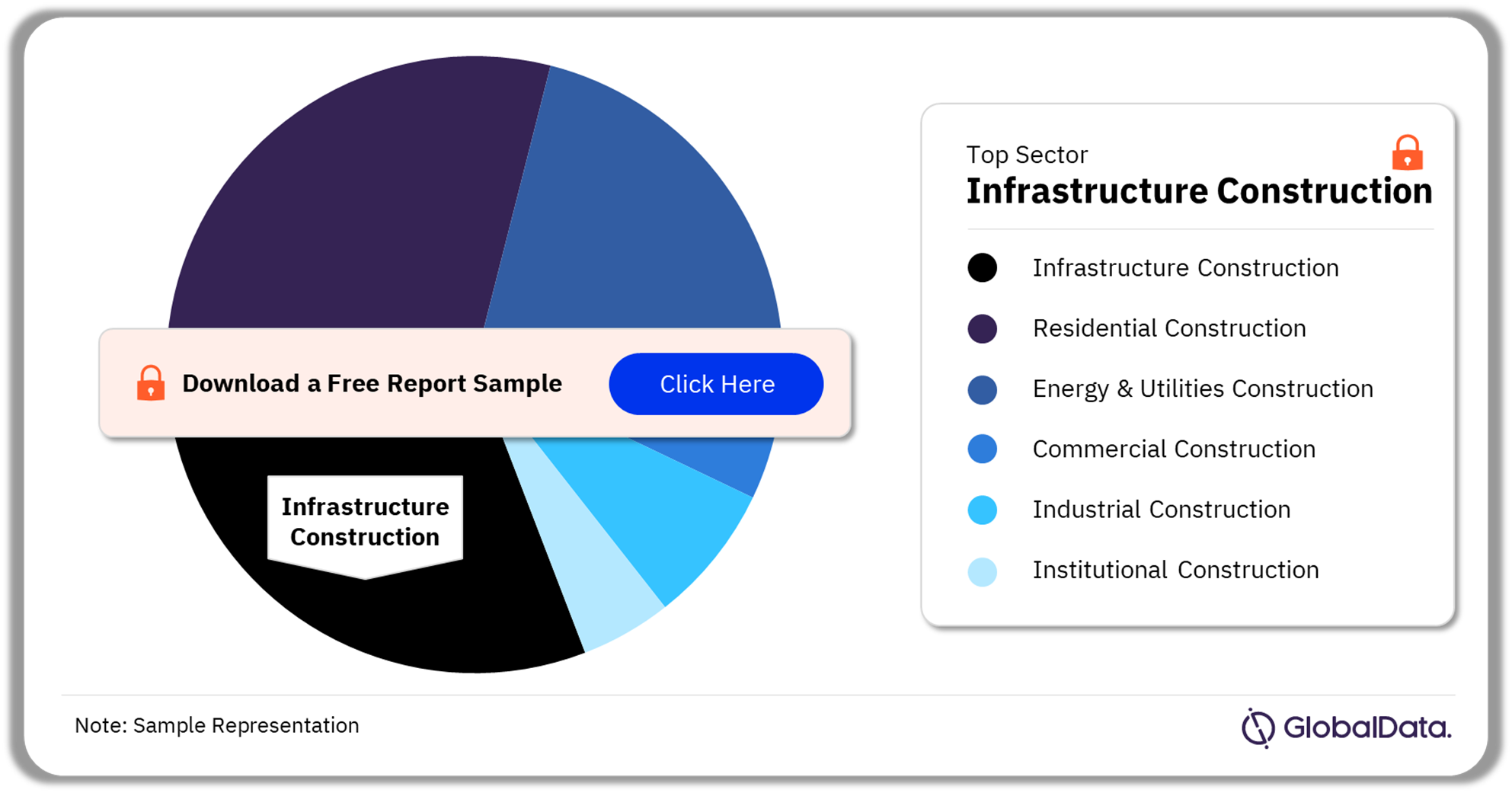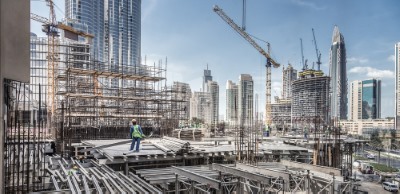South-East Asia Construction Market Size, Trend Analysis by Sector, Competitive Landscape and Forecast, 2023-2027
Powered by ![]()
Access in-depth insight and stay ahead of the market
Explore actionable market insights from the following data in the ‘South-East Asia Construction Market’ report:
- South-East Asia construction market outlook: analysis as well as historical figures and forecasts of opportunities from the sector and regional segments.
- Key Insights on Leading Sectors: Commercial Construction, Energy and Utilities Construction, Industrial Construction, Infrastructure Construction, Institutional Construction, and Residential Construction.
- Overview of the South-East Asia construction industry outlook to 2027.
- Analysis of the construction output values (Real) in major countries: Cambodia, Indonesia, Malaysia, Myanmar, Philippines, Singapore, Thailand, and Vietnam.
- Dedicated section covering key industry participants by country including top consultants and contractors.
How is the ‘South-East Asia Construction Market’ report different from other reports in the market?
Businesses need to have a deeper understanding of the market dynamics to gain a competitive edge in the coming decade. Get the ‘ South-East Asia Construction Market’ report today, which will help you to:
- Evaluate regional trends in construction development from insight into output values and project pipelines.
- Identify the fastest growers to enable assessment and targeting of commercial opportunities in the markets best suited to strategic focus.
- Identify the drivers in the South-East Asia construction market and consider growth in developed economies.
- Formulate plans on where and how to engage with the market while minimizing any negative impact on revenues.
We recommend this valuable source of information to anyone involved in:
- Contractors Including Civil Works, Electrical, HVAC, and Others
- Consultants/Designers
- Building Material Merchants/Players
- Management Consultants and Investment Banks
- Portfolio Managers/Buy-Side Firms
- Strategy and Business Development
- Investment Banking
To Get a Snapshot of the South-East Asia Construction Market Report, Download a Free Report Sample
South-East Asia Construction Market Overview
The construction sector of the South-East Asia region is expected to reach $450.1 billion in 2023, registering a compound annual growth rate (CAGR) of 4.9% over the forecast period. The increasing focus and efforts towards developing regional connectivity through transport infrastructure are anticipated to drive market growth over the near future.
The regional infrastructure construction sector is expected to expand by 4.8% in real terms in 2023, supported by an increasing effort to develop regional transport connectivity. For instance, in April 2023, the Philippines Department of Transportation (DOTr), awarded two contracts worth PHP52.2 billion ($937 million) to a Leighton-First Balfour joint venture and to a Acciona-DMCI joint venture for the Philippines North-South Commuter Railway (NSCR) project.
South-East Asia Construction Market Outlook, 2018-2027 ($ Billion)
Buy the Full Report for Additional Insights on the South-East Asia Construction Market Forecast
GlobalData expects the regional construction industry to showcase a growth of 3.1% in real terms in 2023. The region is estimated to register an annual average growth rate (AAGR) of 6.2% from 2024 to 2027, supported by the expansion in the regional infrastructure sector and the development of new commercial centers to attract more tourists. For instance, the Malaysian government hopes to welcome 16.1 million international tourist arrivals and generate MYR49.2 billion ($11.2 billion) in tourist receipts in 2023, compared with 10.1 million tourist arrivals and MYR28.3 billion ($6.5 billion) in tourist receipts in 2022.
| Market Size (2023) | $450.1 billion |
| CAGR (2023-2027) | 4.9% |
| Historic Period | 2018-2022 |
| Forecast Period | 2023-2027 |
| Report Scope & Coverage | Sector Overview, Construction Output Value ($ Million) by Country and Sector, Regional Outlook by Key Countries, Key Industry Participants |
| Key Sectors | Commercial Construction, Energy and Utilities Construction, Industrial Construction, Infrastructure Construction, Institutional Construction, and Residential Construction |
| Key Countries | Cambodia, Indonesia, Malaysia, Myanmar, Philippines, Singapore, Thailand, and Vietnam |
South-East Asia Construction Market Segmentation by Sectors
The South-East Asia construction industry covers commercial construction, energy and utilities construction, industrial construction, infrastructure construction, institutional construction, and residential construction. The residential construction category is predicted to account for the largest regional share in terms of construction output value (Real) in 2023.
Residential Construction: The residential construction segment is predicted to account for the second-largest regional share in real terms in 2023. The regional segmental growth is expected to remain sluggish this year owing to the deteriorating consumer confidence and affordability issues for potential buyers caused by rising inflation and higher borrowing costs.
However, the regional sectoral growth is anticipated to find momentum in 2024, supported by the construction of new housing units in the region. For instance, the Indonesian government’s plan to carry out projects through public-private partnerships, coupled with its goal of constructing five million housing units by 2027.
South-East Asia Construction Market Share by Sectors, 2023 (%)
Buy the Full Report for Segment-Specific Revenues and Shares
Institutional Construction: This segment is predicted to capture the smallest regional share in real terms in 2023. The South-East Asia institutional construction sector is anticipated to expand by 4.9% in real terms this current year, supported by public- and private-sector investment in the education and healthcare sectors. For instance, in its 2023 Budget, Singapore’s government increased its development expenditure for the healthcare sector by 24.7%, from SGD1.1 billion ($803.2 million) in 2022 to SGD1.4 billion ($1 billion) in 2023.
Infrastructure Construction: The infrastructure construction category is anticipated to register the largest regional share in real terms in 2023, supported by the increasing focus on infrastructure development. For instance, as part of the 2023 State Budget, the Indonesian government increased its allocation for infrastructure development by 7.8%, from IDR363.8 trillion ($23.5 billion) in 2022 to IDR392 trillion ($25.3 billion) in 2023.
Indonesia’s Minister of Finance also asked the Minister of Public Works and Public Housing (PUPR) to complete priority infrastructure projects before the end of President Joko Widodo’s (Jokowi’s) cabinet period in 2024. This includes the construction of roads, airports, railways, bridges, dams, irrigation networks, and housing.
Industrial Construction: The regional institutional construction sector is anticipated to expand by 4.9% in real terms in 2023, supported by public and private sector investments in the education and healthcare sectors. For instance, in its 2023 Budget, Singapore’s government increased its development expenditure for the healthcare sector by 24.7%, from SGD1.1 billion ($803.2 million) in 2022 to SGD1.4 billion ($1 billion) in 2023.
Similarly, in February 2023, the Malaysian government approved an allocation of MYR55.2 billion ($12.6 billion) to the education ministry in the 2023 Budget, up from MYR52.6 billion ($12 billion) in the 2022 Budget. Of the total, MYR2.3 billion ($524.6 million) will be allocated to ensure quality infrastructure and learning facilities for children in schools across the country.
Energy and Utilities Construction: The energy and utilities construction section is predicted to account for the third-largest regional share in real terms in 2023. The sectoral performance in the current year is supported by the development of energy infrastructure, particularly renewable energy.
For instance, the government of the Philippines plans to increase the share of renewable energy in the total power generation mix from 21% in 2020 to 35% by 2030 and 50% by 2040. The country also plans to add 20GW of renewable energy capacity by 2030.
Commercial Construction: The commercial construction sector in the South-East Asia region is expected to grow by 2.5% in real terms in 2023, followed by an annual average growth rate (AAGR) of 6.3% from 2024 to 2027. Over the forecast period, growth will be driven by an improvement in tourism, leisure, and hospitality projects, coupled with increased investment in data center and logistics construction.
For instance, Singapore-based data center company, Princeton Digital Group (PDG), announced in February 2023 that they plan to build a 96MW data center campus in Batam, Indonesia. The campus will be built on 15 acres of land and will feature four buildings of 24MW capacity each.
South-East Asia Construction Market Analysis by Region
The regional construction industry in 2023 is dominated by Indonesia, accounting for 51.0% of the regional share in real terms. Other key countries in the regional mix include Vietnam, Philippines, Malaysia, Thailand, Singapore, Myanmar, and Cambodia.
South-East Asia Construction Market Share by Country, 2023 (%)
Buy the Full Report for Additional South-East Asia Construction Market Insights
The construction industry in Indonesia is expected to expand by 1.2% in real terms in 2023, down from a growth of 2% in 2022. This slowing of growth is due to elevated building material prices, weak commercial property demand, high interest rates and a softening of external demand. The industry’s growth in 2023 will however be supported by the government’s focus on infrastructure development.
Vietnam’s continued efforts to improve its business and investment climate are expected to help the country attract foreign direct investment (FDI) and register the second-largest regional share in real terms in 2023. According to the Ministry of Planning and Investment (MPI), FDI inflows into Vietnam continued to grow in the first five months of 2023. In the first five months of 2023, Vietnam’s FDI inflows reached nearly VND251.6 trillion ($10.9 billion).
The construction industry in the Philippines is estimated to register an annual average growth rate of 7.2% between 2024 and 2027, supported by the government’s focus on the development of the country’s rail and road transport and energy infrastructure, coupled with investment to develop affordable housing and social infrastructure. The government aims to construct one million housing units annually from 2023 to 2028 under the Pambansang Pabahay para sa Pilipino Housing Program (4PH) to address the country’s housing shortage of more than 6.5 million units.
A number of major economies have pledged investment in Malaysia, including China’s commitment to invest MYR170 billion ($38.8 billion) between 2023 and 2028, via the signing of 19 memorandums of understanding (MoUs) between Chinese and Malaysian businesses, including in infrastructure, renewable energy, telecommunications, and tourism.
South-East Asia Construction Market Segments and Scope:
South-East Asia Construction Market Sectors Outlook (Value, $ Million, 2018-2027)
- Commercial Construction
- Energy and Utilities Construction
- Industrial Construction
- Infrastructure Construction
- Institutional Construction
- Residential Construction
South-East Asia Construction Market Countries Outlook (Value, $ Million, 2018-2027)
- Cambodia
- Indonesia
- Malaysia
- Myanmar
- Philippines
- Singapore
- Thailand
- Vietnam
Key Highlights
The South-East Asia construction market size will be evaluated at $450.1 billion in 2023. The construction market in the South-East Asia region is expected to grow at a CAGR of 4.9% during 2023-2027.
Key Players
Table of Contents
Table
Figures
Frequently asked questions
-
What was the South-East Asia construction market size in 2023?
The South-East Asia construction market size will be evaluated at $450.1 billion in 2023.
-
What is the South-East Asia construction market growth rate?
The construction market in the South-East Asian region is expected to grow at a CAGR of 4.9% during 2023-2027.
-
What are the key sectors in the South-East Asia construction market?
The key sectors in the South-East Asia construction market are commercial construction, energy and utilities construction, industrial construction, infrastructure construction, institutional construction, and residential construction.
-
Which are the key countries in the South-East Asia construction market?
The key countries in the South-East Asia construction market are Cambodia, Indonesia, Malaysia, Myanmar, Philippines, Singapore, Thailand, and Vietnam.
-
Is there a third level of segmentation in the report?
GlobalData’s focus is on providing reliable and accurate data that is supported by robust research methodology. Our reports undergo rigorous quality checks and are based on primary and secondary research sources, ensuring that the numbers and insights provided are trustworthy. However, despite the best efforts to gather comprehensive data, there could be instances where the available data is limited, making it challenging to provide third-level segmentation. In such cases, GlobalData may choose to provide high-level insights and general trends rather than forcing segmentation that may not be backed by sufficient data. This approach ensures that the report’s overall quality and credibility are maintained.
Get in touch to find out about multi-purchase discounts
reportstore@globaldata.com
Tel +44 20 7947 2745
Every customer’s requirement is unique. With over 220,000 construction projects tracked, we can create a tailored dataset for you based on the types of projects you are looking for. Please get in touch with your specific requirements and we can send you a quote.













